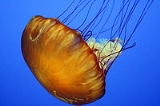
Jellyfish
Overview
Jellyfish are free-swimming members of the phylum Cnidaria
. Medusa
is another word for jellyfish, and refers to any free-swimming jellyfish stages in the phylum Cnidaria. Jellyfish have several different morphologies
that represent several different cnidarian classes including the Scyphozoa
(over 200 species), Staurozoa (about 50 species), Cubozoa (about 20 species), and Hydrozoa
(about 1000–1500 species that make jellyfish and many more that do not).
Jellyfish are found in every ocean, from the surface to the deep sea.
Cnidaria
Cnidaria is a phylum containing over 9,000 species of animals found exclusively in aquatic and mostly marine environments. Their distinguishing feature is cnidocytes, specialized cells that they use mainly for capturing prey. Their bodies consist of mesoglea, a non-living jelly-like substance,...
. Medusa
Medusa (biology)
In biology, a medusa is a form of cnidarian in which the body is shaped like an umbrella, in contrast with polyps. Medusae vary from bell-shaped to the shape of a thin disk, scarcely convex above and only slightly concave below...
is another word for jellyfish, and refers to any free-swimming jellyfish stages in the phylum Cnidaria. Jellyfish have several different morphologies
Morphology (biology)
In biology, morphology is a branch of bioscience dealing with the study of the form and structure of organisms and their specific structural features....
that represent several different cnidarian classes including the Scyphozoa
Scyphozoa
Scyphozoa is a class within the phylum Cnidaria, sometimes referred to as the "true jellyfish".The class name Scyphozoa comes from the Greek word skyphos , denoting a kind of drinking cup and alluding to the cup shape of the organism....
(over 200 species), Staurozoa (about 50 species), Cubozoa (about 20 species), and Hydrozoa
Hydrozoa
Hydrozoa are a taxonomic class of very small, predatory animals which can be solitary or colonial and which mostly live in saltwater. A few genera within this class live in freshwater...
(about 1000–1500 species that make jellyfish and many more that do not).
Jellyfish are found in every ocean, from the surface to the deep sea.
Unanswered Questions

